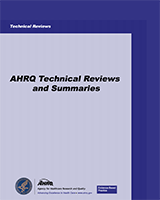Developing a Methodology for Establishing a Statement of Work for a Policy-Relevant Technical Analysis
Technical Reviews, No. 11
Authors
Investigators: David B Matchar, MD, FACP, Meenal Patwardhan, MD, MHSA, Antonio Sarria-Santamera, MD, PhD, and Emma V Westermann-Clark, BS.Affiliations
Structured Abstract
Context:
The Duke Evidence-based Practice Center (EPC) initiated a project designed to improve the process of generating reports that synthesize and evaluate the scientific literature on topics of particular interest to health care policymakers, clinicians, and other decisionmakers. The project focused on two improvement opportunities: process efficiency and stakeholder satisfaction. We organized the analysis around the concept of a “statement of work (SOW).” As a contractual document, the SOW is the tangible manifestation of the objectives of each EPC project, serving as a foundation for interaction between involved parties, including technical details such as budget, timeline, and deliverables.
Objective:
To identify potential solutions to the core constraints identified by the study.
Methods:
The project proceeded in four steps: an interview of participants in the EPC process; a review of the technical contracting literature relating to formulating SOWs for the production of policy reports and similar intellectual products, and policy literature related to the determinants of a successful policy analysis; a synthesis of both the interview results and literature review utilizing tools suggested by the Theory of Constraints (TOC).
TOC methods were applied to the initial results in order to identify a common undesirable effect (UDE) related to EPC reports: a report that does not get used is unsuccessful and is deemed fundamentally undesirable. A current reality tree (CRT) was constructed by working from this fundamental UDE at the top through proximate causes, and finally root causes identified during the process.
Conclusions:
The analysis identified several problems that ultimately result in a report not meeting the partner's needs, and therefore not being used. The most significant problem, i.e. the core constraint (the most important target for improvement), identified was that the partner does not know how to conceptualize and articulate needs, objectives, and specifications. Several major potential change strategies for this core constraint were then explored. Two change strategies: establish an ongoing relationship between partners, EPC, and AHRQ early in the process, and utilize a changes clause were deemed to be the most practical means to exert impact on the SOW process by addressing this core constraint. In the final step, a Future Reality Tree was constructed representing an illustration of the impact of the proposed solutions on the EPC's SOW process.
Prepared for: Agency for Healthcare Research and Quality, U.S. Department of Health and Human Services.1 Contract No. 290-02-0025. Prepared by: Duke Evidence-based Practice Center, Durham, NC.
Suggested citation:
Matchar DB, Patwardhan M, Sarria-Santamera A, Westermann-Clark EV. Developing a Methodology for Establishing a Statement of Work for a Policy-Relevant Technical Analysis. Technical Review 11. (Prepared by the Duke Evidence-based Practice Center under Contract No. 290-02-0025.) AHRQ Publication No. 06-0026. Rockville, MD: Agency for Healthcare Research and Quality. January 2006.
This report is based on research conducted by the Duke Evidence-based Practice Center (EPC) under contract to the Agency for Healthcare Research and Quality (AHRQ), Rockville, MD (Contract No. 290-02-0025). The findings and conclusions in this document are those of the author(s), who are responsible for its content, and do not necessarily represent the views of AHRQ. No statement in this report should be construed as an official position of AHRQ or of the U.S. Department of Health and Human Services.
The information in this report is intended to help clinicians, employers, policymakers, and others make informed decisions about the provision of health care services. This report is intended as a reference and not as a substitute for clinical judgment.
This report may be used, in whole or in part, as the basis for the development of clinical practice guidelines and other quality enhancement tools, or as a basis for reimbursement and coverage policies. AHRQ or U.S. Department of Health and Human Services endorsement of such derivative products may not be stated or implied.
- 1
540 Gaither Road, Rockville, MD 20850. www
.ahrq.gov
